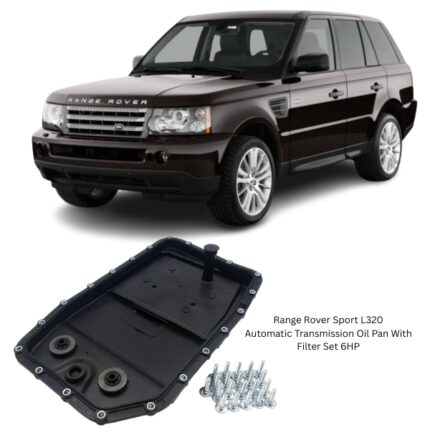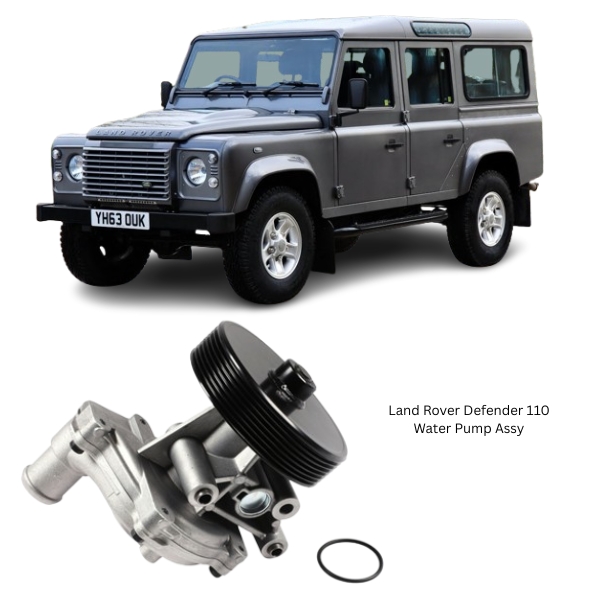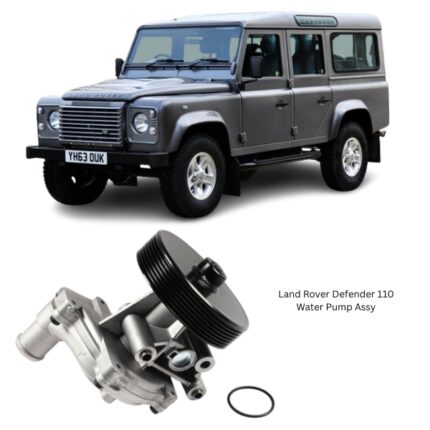Get Land Rover Defender 110 Water Pump Assy LR156697A in Kenya
The Water Pump Assembly is a fundamental component of a vehicle’s cooling system. It plays a crucial role in regulating engine temperature by circulating coolant from the radiator, through the engine block, and back to the radiator for cooling. Often driven by the engine’s timing belt, serpentine belt, or chain, the water pump operates continuously while the engine is running. A properly functioning water pump ensures consistent coolant flow, preventing engine overheating and ensuring optimal performance and longevity.
In this comprehensive guide, we’ll explore the construction, operation, importance, symptoms of failure, maintenance, and replacement of the water pump assembly.
1. What Is the Water Pump Assembly?
The Water Pump Assembly refers to the complete unit responsible for the circulation of coolant in an internal combustion engine. It typically consists of a housing, an impeller (fan-like structure), a shaft and bearing system, a pulley or gear, and a gasket or sealing system.
Depending on the vehicle, the pump may be mechanical (driven by the engine) or electric (controlled by the ECU). Mechanical water pumps are more common in traditional engines, while electric pumps are increasingly used in modern and hybrid systems.
2. Main Components of the Water Pump Assembly
The assembly includes several key parts:
-
Housing: Made of aluminum, cast iron, or plastic, it encases and supports the internal components.
-
Impeller: A rotating blade-like part, usually metal or reinforced plastic, that pushes coolant through the engine.
-
Shaft and Bearing: Connects the impeller to the pulley, enabling rotation while supporting axial and radial loads.
-
Pulley or Gear: Transfers motion from the engine’s belt or chain to the pump.
-
Seal or Gasket: Prevents coolant from leaking at the shaft or mounting surface.
-
Weep Hole: A small drain hole that alerts to internal seal failure by allowing coolant or oil to escape visibly.
3. How the Water Pump Works
The water pump operates by harnessing rotational energy from the engine:
-
As the engine runs, the serpentine belt or timing belt/chain turns the water pump pulley.
-
This motion rotates the impeller inside the housing.
-
The impeller creates centrifugal force, drawing coolant from the radiator into the pump.
-
The coolant is pushed through the engine block and cylinder head passages, absorbing heat.
-
The heated coolant returns to the radiator to be cooled before the cycle repeats.
This constant circulation keeps the engine at a safe operating temperature, usually around 90°C (194°F), preventing overheating or excessive thermal stress.
4. Importance of the Water Pump in Engine Performance
The water pump is vital to:
-
Preventing Overheating: If coolant doesn’t circulate properly, the engine can overheat quickly.
-
Maintaining Engine Efficiency: Stable operating temperatures ensure consistent combustion and performance.
-
Protecting Engine Components: Excess heat can warp the cylinder head, damage gaskets, and crack the engine block.
-
Supporting Ancillary Systems: Some water pumps also cool the turbocharger, battery pack (in hybrids), or HVAC system.
Without a functioning water pump, the engine would quickly overheat, leading to catastrophic failure.
5. Types of Water Pumps
-
Mechanical Water Pump: Belt-driven, most common in combustion engine vehicles.
-
Electric Water Pump: Controlled by the engine control unit (ECU), allows variable flow and improved efficiency. Common in modern turbocharged and hybrid engines.
-
Auxiliary Water Pump: Secondary pump used for HVAC systems or electric vehicles.
6. Symptoms of a Failing Water Pump
Over time, water pumps wear out due to continuous operation, coolant corrosion, or bearing fatigue. Common signs of failure include:
a) Coolant Leak
-
Visible coolant puddles under the engine.
-
Leaks from the weep hole indicate internal seal failure.
b) Overheating Engine
-
Rising temperature gauge or warning light.
-
Loss of coolant circulation due to impeller failure or leak.
c) Whining or Grinding Noise
-
Worn bearings inside the pump produce noise during rotation.
-
May vary with engine speed.
d) Steam from the Radiator
-
Indicates high pressure and boiling coolant caused by circulation failure.
e) Corroded or Rusted Water Pump
-
Visible corrosion on the housing or impeller often leads to inefficiency or failure.
f) Coolant Contamination
-
Rust particles or oily residue in the coolant reservoir may indicate pump or gasket failure.
7. Causes of Water Pump Failure
-
Worn Bearings or Seals: Due to age, heat, or belt tension.
-
Coolant Quality Issues: Old or contaminated coolant causes internal rust or mineral buildup.
-
Excessive Belt Tension: Over-tightened belts put strain on pump bearings.
-
Impeller Damage: Erosion or corrosion reduces coolant flow.
-
Dry Running: Running the engine without coolant damages the seal and impeller.
8. Maintenance Tips for a Healthy Water Pump
-
Regular Coolant Changes: Flush and replace coolant as per manufacturer guidelines (usually every 2–5 years).
-
Use the Right Coolant: Always use the manufacturer-recommended type and mix ratio.
-
Inspect Belts: Replace worn or cracked belts and tensioners during service.
-
Monitor Engine Temperature: Sudden changes in engine temperature should be investigated immediately.
-
Check for Leaks: Periodically inspect the pump area and under the car for coolant residue.
9. Water Pump Replacement Process
Replacing a water pump can vary in complexity depending on its location (timing belt side vs. accessory belt side). A typical mechanical pump replacement involves:
Tools Needed:
-
Socket and wrench set
-
Torque wrench
-
Drain pan
-
Gasket scraper
-
Coolant
-
Belt tensioner tool (if required)
Steps:
-
Drain the Coolant: Remove radiator cap and open the drain plug.
-
Remove Drive Belts: Loosen and remove belts connected to the pump.
-
Disconnect Components: Remove hoses, tensioners, or accessories obstructing access.
-
Remove the Old Pump: Unbolt the pump and remove the old gasket or sealant.
-
Clean the Mating Surface: Ensure a smooth, debris-free area for the new pump.
-
Install New Pump: Apply gasket or sealant, then torque bolts to spec.
-
Reconnect Belts and Components: Reinstall everything removed during disassembly.
-
Refill Coolant: Use the proper coolant mix and bleed the system of air.
-
Test: Start the engine, check for leaks, and monitor temperature gauge.
Note: If the pump is driven by the timing belt, it is often replaced together with the belt and tensioners to avoid future labor costs and potential breakdowns.
Follow us on Facebook for more parts.





Reviews
Clear filtersThere are no reviews yet.